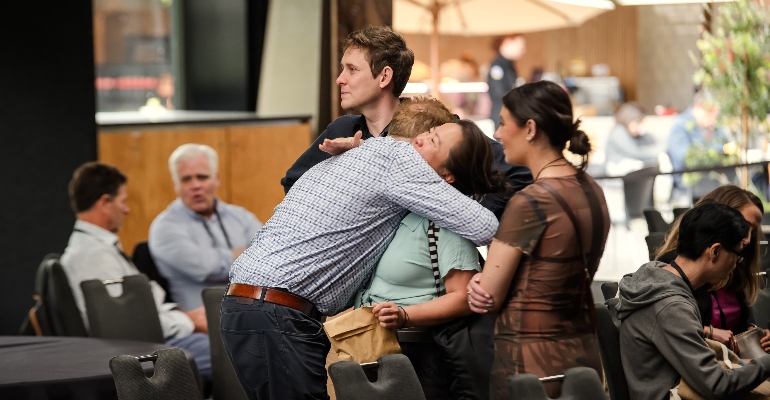Effective collaboration is built on strong (micro)foundations
31 January 2024 | Read time: 6 minutes

How do we get people to work together to tackle the global challenges of our time? That’s one of the big questions being asked by a major SfTI programme, ‘Building New Zealand’s Innovation Capacity (BNZIC)’. This unique longitudinal study is tasked with researching the researchers and identifying exactly what it is that nurtures effective innovation.
For the duration of the Challenge, BNZIC’s team of social scientists has been collecting data from across our Spearhead projects, to explore how each of those collaborations has evolved over time. They’ve carried out detailed interviews, observed at meetings and workshops in-person and online, and reviewed reports and papers coming out of each project.

This rich, multi-year dataset allowed them to identify a series of barriers that can exist within large, interdisciplinary teams. And in a new paper published in the journal R&D Management, our scientists have shown that carefully-designed workshops, delivered at the right time, can overcome those barriers, and support teams to more effectively deliver ambitious science goals.
Building trust in mission-led science teams
Solving big societal challenges – as is the aim of all mission-led research – requires more than a room full of experts sharing their findings. The most productive collaborations are those that also include a lot of trust as well as clear communication amongst people and their organisations. A growing body of evidence suggests that an effective way to build this trust and forge connections across disparate research disciplines is through paying attention to microfoundations – individual behaviours, attitudes, priorities, motivations, and experiences.

Because microfoundations shape social interactions, they have a significant role in defining team dynamics. For instance, shared motivations build empathy, which can be a catalyst for collaboration. But, differences in disciplinary norms can stifle idea sharing, impeding collaboration.
In the current study, researchers identified 18 barriers that they say can lead to ineffective or suboptimal collaborations in mission-led research. They include the existence of disciplinary silos and lack of a common language, miscommunication between individuals, unclear team objectives, the complexity of the research problem, and the time required to build relationships.
To explore how these barriers could be practically addressed, the researchers chose two relatively new SfTI science teams – one focused on additive manufacturing and the other on robotics – and ran a bespoke workshop for each.
Experimenting with design thinking
These workshops were based on a structured design approach known as Concept-Knowledge (C-K). It uses three broad principles to enable interdisciplinary collaboration
- Knowledge mapping, which involves unveiling the total knowledge base of an interdisciplinary group in order to identify areas of commonality.
- Concept exploration, which aims to develop original ideas that offer non-conventional pathways to solving a problem.
- Mindful deviation, which is about reframing; consciously stepping away from established disciplinary structures that can cause ‘fixed’ thinking.
The researchers wanted to understand whether the C-K approach could be used to avoid some of the collaboration barriers they had identified; instead, supporting those microfoundations known to enhance cooperation.
During the four-hour workshop, the participants – which included engineers, product designers, biomaterials researchers, computer scientists and managers – were guided through four structured, conversation-led activities. Each activity was constructed so that it would explore one, two, or all three of the C-K design principles, and while participants worked on them, BNZIC researchers collected extensive observational data. This took the form of audio recordings, photos of participants’ interactions, body movements and postures, and detailed ‘field notes’ that captured their impressions of every subgroup and whole-group interaction. Participants were also assigned a photo-task activity, in which they were asked to capture a photo that summarised their personal experiences and impressions of the workshop.
They found that knowledge mapping helped to form strong social bonds between individuals, and fostered a sense of shared direction. Concept exploration enabled more open conversations that retained technical depth. Mindful deviation worked to flatten institutional hierarchies, and saw individuals ‘unfix’ themselves from the rigid roles they hold outside the project.
This analysis demonstrates that design-led principles, deployed in a formalised, structured manner, can be hugely beneficial when building large mission-led research collaborations. The authors say that the C-K workshop “…. not only played a positive role in helping individuals overcome barriers to cross-organisation interdisciplinary research in a surprisingly short amount of time, but also did so in a way that enabled thinking differently and generating creative ideas.”
---
Original research paper (open access): Rafaela Costa Camoes Rabello, Katharina Ruckstuhl, Paul Woodfield, Olga Kokshagina, and Susan Sandretto, “The microfoundations of mission-led interdisciplinary collaborations: The role of design principles”, R&D Management